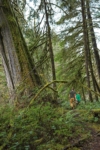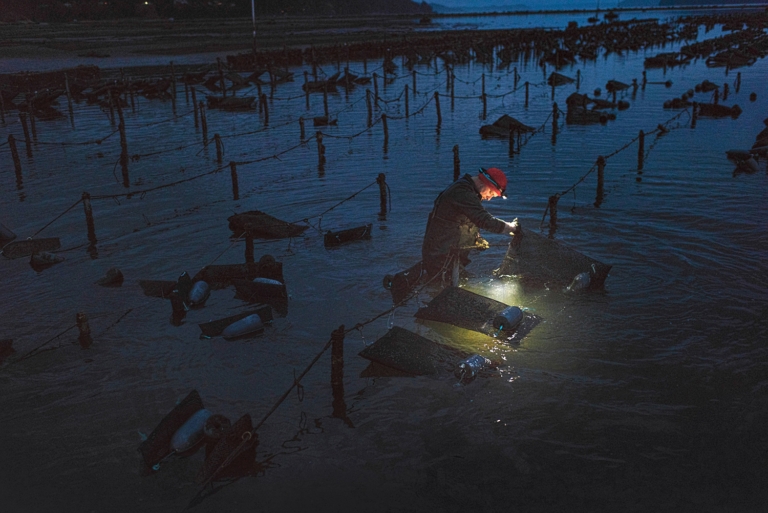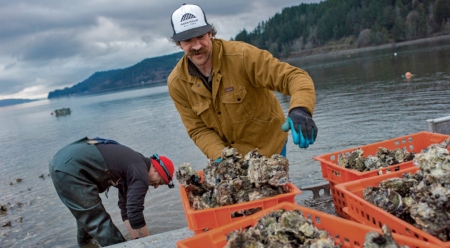Timber to Tideline: Hama Hama Oysters
“For us, the tide is the boss,” says Adam James of Hama Hama Oysters, a fifth-generation, family-run shellfish farm on Washington’s Puget Sound.
“In late August and September, we’ll be out there on the beach harvesting at 3 or 4 a.m., and when the sun finally comes up you can’t help but pause. It reminds me of those moments before we had Instagram, when you’d just take in a moment and appreciate how lucky you are. There aren’t many people who work like this nowadays.”
Adam’s family has been operating the farm since 1890, when his great-great-grandfather bought the lands surrounding the mouth of the Hamma Hamma River. With its source high in the protected Olympic Mountains, the river’s clean waters have always been crucial to the family business.
“There’s an interplay between fresh- and saltwater,” notes Adam’s sister, Lissa James Monberg. “The salinity, temperature and food all determine an oyster’s flavor, and those factors vary from bay to bay. Oysters eat algae fueled by estuarine nutrients, but they also consume tiny bits of organic material from the upstream environment. So the quality of the freshwater will have a big impact on the flavor of the oysters downstream. The purity of the river influences the flavor of the oysters, so we’re extremely fortunate to be farming at the mouth of a river that spends most of its time in pristine rainforest.”

A day of trail maintenance in the upstream watershed. “Ours is a story about people as well as place,” says Lissa James Monberg, “and we know that our future and the future of this place are one and the same.” Photo: Garrett Grove
The family also runs a timbering operation in the hills above the farm, harvesting selectively on a longer rotation that encourages diversity within the forest structure. But for Adam, whose first job was digging clams for $10 a bucket as a grade-schooler, most days are spent in rubber boots in the intertidal zone.
“We grow our Hama Hama oysters right on the river delta and our Blue Pools in tumble bags that rise and fall with the tide,” he explains. “We generally show up three hours before low tide, pick the oysters into crates or a bucket, and put them in harvest sacks. Six hours later, we go out on a barge for high tide, grab the sacks with a grapple and then bring them in.”

Cory Logan works the early shift in the tumble farm. This method of oyster farming, with the oysters grown in porous bags that rise and fall with the tide, creates deeper cups and a sharper flavor. Photo: Garrett Grove
“Oystering aligns environmental and economic interests in a neat way,” he continues. “We’re producing a tangible product, but we also want this to be a restorative fishery. It’s a high-quality protein that doesn’t require a lot of inputs in terms of resources, and it allows us to keep tending to this place we’ve inherited. We get to work in a pretty amazing spot—now the biggest thing is to not mess it up.”

A freshly shucked Hama Hama oyster waiting to be slurped. Without clean water, shellfish this good wouldn’t be possible. Photo: Garrett Grove
WORKWEAR
Workwear is not a new thing for us, but we’re excited to be reimagining the work-specific side of Patagonia. To stand up to the toughest tasks, we’ve developed a utilitarian line of jackets, shirts and pants built with super-durable, long-wearing fabrics like Iron Forge Hemp™ canvas—an innovative, heavy-duty blend of industrial hemp, recycled polyester and organic cotton. It’s 25% more abrasion resistant than conventional cotton duck canvas and needs no break-in; and our hemp-blend workwear clothing is also Fair Trade Certified™ for sewing. See the collection at patagonia.com/workwear.
HAMA HAMA OYSTERS
To learn more about Hama Hama Oysters and support their work, please visit hamahamaoysters.com.
This story first appeared in the 2017 Patagonia Workwear Catalog.

